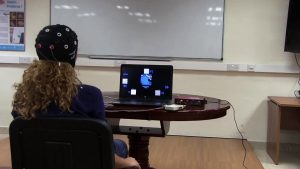Meditation Improves the Ability to Interface the Brain to Computers
By John M. de Castro, Ph.D.
“Brain–computer interfaces (BCIs) are promising tools for assisting patients with paralysis, but suffer from long training times and variable user proficiency. Mind–body awareness training (MBAT) can improve BCI learning.” – ScienceDaily
It has long been a dream to develop methods to allow the brain to directly alter external devices. The efforts have been focused on developing a brain-computer interface such that recorded electrical activity of the brain is interfaced with a computer allowing control of the computer by the activity. It is hypothesized that a brain computer interface might be able to provide an alternative method to control muscles in patients with severe neuromuscular diseases.
Brain-computer interface methods have been developed but suffer from long training times before the participant is capable of affecting the computer activity. Meditation has been shown to alter the activity of the brain. Meditation training may make the individual better at controlling their brain activity. Hence, an interesting research question is to investigate whether meditation practitioners are better able to learn to control a computer with the brain’s electrical activity.
In today’s Research News article “Effects of Long-Term Meditation Practices on Sensorimotor Rhythm-Based Brain-Computer Interface Learning.” (See summary below or view the full text of the study at: https://www.ncbi.nlm.nih.gov/pmc/articles/PMC7858648/ ) Jiang and colleagues recruited 2 groups of healthy adults without brain-computer interface experience; one with at least two years of meditation practice and one without meditation experience. They were all measured for mindfulness. They all participated in 6 weekly, 1-hour, brain-computer interface training. Their brain electrical activity was recorded with an electroencephalogram (EEG) the electrical activity in the motor cortex was connected to a computer which moved a cursor over the screen. The participants were asked to try to move the cursor left or right by imagining opening and closing the left or right hand, to move the cursor up by imagining opening and closing both hands and down by resting.
They found that the meditators had significantly better performance throughout training. Improvement occurred at approximately the same rate but the meditators started off at a higher baseline. The recording of alpha rhythm power over the motor cortex increased in both groups over training. In addition, they found that the higher the level of mindfulness before training, the better the performance with the meditators having significantly higher levels of mindfulness.
This is an interesting study but it should be kept in mind that the meditators may be different from non-meditators in ways other than the meditation practice. Being better able to control their brain activity may be characteristic of people who choose to meditate, Nevertheless, the results demonstrate that adults can alter the electrical activity in their motor cortex by imagining opening and closing their hands and that they can learn to increase this with feedback from a moving cursor. Meditators appear to have a leg up in learning this task with being better able to control their brain activity right from the beginning. This suggests that meditation practice improves the individual’s ability to alter their brain activity making them capable of learning a brain-computer interface task faster.
So, meditation improves the ability to interface the brain to computers.
“Brain–computer interfaces (BCIs) are promising tools for assisting patients with paralysis, but suffer from long training times and variable user proficiency. Mind–body awareness training (MBAT) can improve BCI learning.” – James Stieger
CMCS – Center for Mindfulness and Contemplative Studies
This and other Contemplative Studies posts are also available on Google+ https://plus.google.com/106784388191201299496/posts and on Twitter @MindfulResearch
Study Summary
Jiang, X., Lopez, E., Stieger, J. R., Greco, C. M., & He, B. (2021). Effects of Long-Term Meditation Practices on Sensorimotor Rhythm-Based Brain-Computer Interface Learning. Frontiers in neuroscience, 14, 584971. https://doi.org/10.3389/fnins.2020.584971
Abstract
Sensorimotor rhythm (SMR)-based brain–computer interfaces (BCIs) provide an alternative pathway for users to perform motor control using motor imagery. Despite the non-invasiveness, ease of use, and low cost, this kind of BCI has limitations due to long training times and BCI inefficiency—that is, the SMR BCI control paradigm may not work well on a subpopulation of users. Meditation is a mental training method to improve mindfulness and awareness and is reported to have positive effects on one’s mental state. Here, we investigated the behavioral and electrophysiological differences between experienced meditators and meditation naïve subjects in one-dimensional (1D) and two-dimensional (2D) cursor control tasks. We found numerical evidence that meditators outperformed control subjects in both tasks (1D and 2D), and there were fewer BCI inefficient subjects in the meditator group. Finally, we also explored the neurophysiological difference between the two groups and showed that the meditators had a higher resting SMR predictor, more stable resting mu rhythm, and a larger control signal contrast than controls during the task.
https://www.ncbi.nlm.nih.gov/pmc/articles/PMC7858648/
